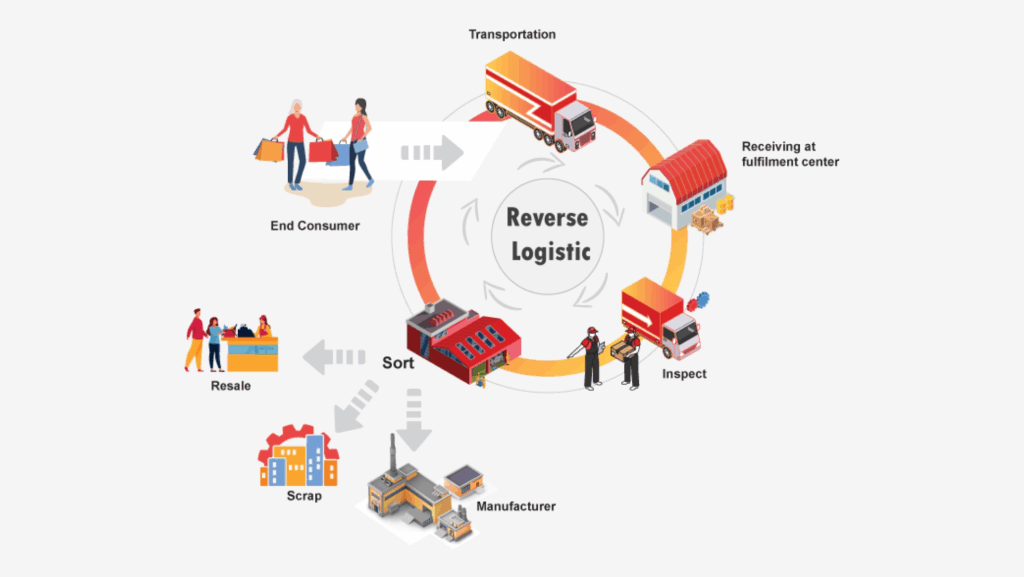Reverse Logistics Courier Tracking 2025 Ultimate Guide
Returns are a constant reality for online stores, and how they are handled can make or break customer loyalty. A smooth return process builds trust, while a poor one drives buyers to competitors. Reverse logistics courier tracking offers businesses full visibility over every parcel sent back, reducing confusion, costs, and disputes. This guide explores how reverse logistics works, why tracking is essential, and how businesses can build smarter systems to handle returns effectively.

What Is Reverse Logistics Courier Tracking?
Reverse logistics courier tracking is the process of monitoring goods as they travel back from customers to businesses. Unlike standard shipping, where the focus is on delivering new products, reverse logistics tracking ensures transparency during returns, repairs, recycling, or disposal.
Key Components of Reverse Logistics Tracking
- Return initiation – the customer requests a return, often with an automated form.
- Label generation – a return label or QR code is issued instantly.
- Courier updates – the package is scanned and tracked as it moves back.
- Final resolution – once received, the business refunds, repairs, or exchanges.
This system not only streamlines returns but also makes the process easier for both the buyer and the brand.
Why Reverse Tracking Matters More Than Ever
Returns are costly. Studies show that return rates in eCommerce average between 20% and 30%. Without clear tracking, returns quickly become a logistical nightmare. Reverse logistics courier tracking addresses these challenges by creating a reliable flow of information.
Benefits for Businesses
- Lower operational risk – no more missing packages or uncertain timelines.
- Customer reassurance – buyers feel confident when they can track their return.
- Faster stock recovery – products re-enter the inventory more quickly.
- Regulatory compliance – many regions require documented return handling.
Benefits for Customers
- Peace of mind – tracking reduces stress over whether a return is received.
- Transparency – no guessing about refund timelines.
- Convenience – easier to plan around courier pickups or drop-offs.

Challenges Without Smart Tracking
When companies lack reverse logistics tracking, they face:
- Increased disputes – customers claim refunds without proof of delivery.
- Extra support calls – staff waste time manually checking return status.
- Inventory uncertainty – stock levels remain inaccurate.
- Brand damage – shoppers avoid brands with complicated returns.
These problems directly impact revenue and reputation.
Best Practices for Smarter Returns
To make reverse logistics efficient, businesses should adopt clear strategies:
- Provide prepaid return labels – eliminate hassle for customers.
- Integrate real-time tracking – keep both sides updated automatically.
- Offer multiple courier options – give flexibility on price and speed.
- Centralize data – manage returns through one platform.
- Analyze data regularly – track reasons for returns to reduce future issues.
Postalparcel supports businesses with global courier connections and centralized reverse logistics courier tracking. By integrating tools like this, brands can transform returns from a burden into a competitive strength.
How Technology Transforms Reverse Logistics
Modern reverse logistics tracking uses automation and data integration. When connected with eCommerce systems, the process becomes seamless.
- Step 1: Request – customer selects “return” on the website.
- Step 2: Label – courier label is automatically generated.
- Step 3: Pickup/Drop-off – parcel is scanned into the courier’s network.
- Step 4: Tracking – updates are sent via email or SMS.
- Step 5: Resolution – refund, repair, or replacement is confirmed.
This chain reduces human error and ensures full visibility.

Customer Expectations in the Digital Era
Today’s shoppers expect returns to be as easy as purchases. Tracking plays a critical role in shaping their satisfaction.
What Customers Want in Returns
- Simplicity – no long forms or unclear policies.
- Visibility – real-time tracking for reassurance.
- Speed – fast refunds once the item is confirmed delivered.
- Choice – courier pick-up, parcel lockers, or drop-off points.
If brands fail to meet these expectations, buyers will move to competitors who do.
Cross-Border Returns and Global Logistics
Handling domestic returns is challenging enough, but global returns add another layer of complexity. Issues like customs clearance, variable courier standards, and international shipping costs can delay refunds.
Reverse logistics courier tracking bridges these gaps by ensuring consistent visibility across borders. Postalparcel specializes in international carrier management, helping businesses maintain clear tracking even in complex global returns.
Challenges in Cross-Border Returns
- Customs delays.
- Higher shipping costs.
- Multiple courier handovers.
- Compliance with international return laws.
How Tracking Helps
- Provides end-to-end parcel visibility.
- Ensures faster customs processing with correct documentation.
- Gives customers reassurance, even across long distances.

Environmental and Sustainability Aspects
Returns have an environmental impact. Each shipment adds to carbon emissions, and improperly handled goods often end up as waste. Smarter reverse logistics tracking can help reduce this footprint.
- Optimized routes reduce unnecessary courier trips.
- Faster processing ensures goods are resold instead of discarded.
- Data insights reveal patterns in returns, helping brands improve product quality.
Sustainable logistics is now a key driver of brand image. Companies that show they care about reducing waste gain an advantage in customer loyalty.
Reverse Logistics as a Growth Opportunity
For many businesses, returns are seen as a cost center. But with reverse logistics courier tracking, they become an opportunity.
- Turn returns into exchanges – offering customers store credit encourages repeat purchases.
- Recover resale value – returned goods can quickly be inspected and resold.
- Collect valuable data – return trends help improve product design.
Instead of fighting returns, forward-thinking businesses leverage them to build stronger customer relationships.
Future of Reverse Logistics Tracking
Looking ahead, reverse logistics will continue to evolve with technology.
- AI-powered forecasting – predicting return rates and planning resources.
- IoT-enabled parcels – smart tags providing live updates.
- Blockchain solutions – tamper-proof return tracking for high-value items.
- Eco-friendly returns – using carbon-neutral couriers and recyclable packaging.
Businesses that adapt early will gain both operational and competitive advantages.

Conclusion
Reverse logistics courier tracking is the foundation of smarter returns. It creates transparency, reduces costs, and builds customer trust. Brands that fail to invest risk losing loyalty, while those that embrace smarter tracking turn returns into a growth opportunity. Postalparcel offers solutions that connect couriers worldwide, giving businesses the visibility they need to manage returns with confidence. With the right systems in place, returns shift from being a burden to becoming a driver of customer satisfaction and long-term success.
FAQ
1. What is reverse logistics courier tracking?
It is the process of monitoring and managing returned goods as they move back from customers to warehouses or repair centers, ensuring full visibility and transparency.
2. Why is reverse logistics tracking important for eCommerce?
It reduces lost parcels, speeds up refunds, improves inventory planning, and builds customer trust by providing real-time updates on returns.
3. How does reverse logistics courier tracking work?
The process begins when a customer requests a return, a courier label is created, and the package is tracked through every stage until it is received and resolved.
4. What are the main challenges in reverse logistics without tracking?
Businesses may face disputes, higher costs, delayed refunds, and poor customer satisfaction due to a lack of visibility and communication.
5. Can reverse logistics courier tracking improve customer loyalty?
Yes, a transparent and easy return process makes customers feel secure, increasing their chances of buying again from the same brand.
Industry Insights
news via inbox
Nulla turp dis cursus. Integer liberos euismod pretium faucibua







